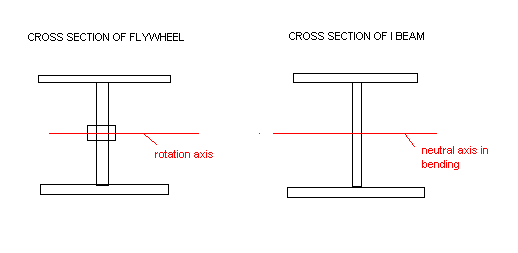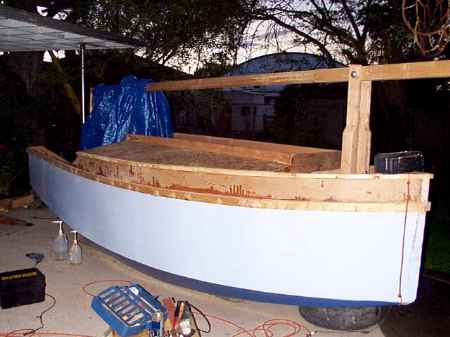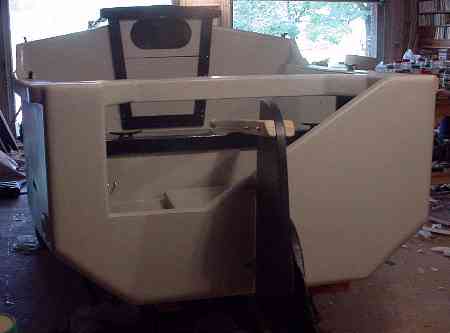
Eric Cosens takes his Piccup Squared project out for a driveway sail.
Contents:
Contact info:
Jim Michalak
118 E Randall,
Lebanon, IL 62254Send $1 for info on 20 boats.
Jim Michalak's Boat Designs
118 E Randall, Lebanon, IL 62254
A page of boat designs and essays.
(1oct06) This issue will continue the panel stiffness essays. The 15 October issue will complete the topic.
THE BOOK IS OUT!
BOATBUILDING FOR BEGINNERS (AND BEYOND)
is out now, written by me and edited by Garth Battista of Breakaway Books. You might find it at your bookstore. If not check it out at the....ON LINE CATALOG OF MY PLANS...
...which can now be found at Duckworks Magazine. You order with a shopping cart set up and pay with credit cards or by Paypal. Then Duckworks sends me an email about the order and then I send the plans right from me to you.

|
Left:
Eric Cosens takes his Piccup Squared project out for a driveway sail.
|
|
|
Panel Stiffness 3
TO RECAP...In the first episode we found that if we made a beam that was rectangular in cross section twice as deep, it became four times as strong and eight times as stiff as the original. In particular, the stresses if our 200# man sat in the middle of his 8' long 4x4 the resulting maximum stresses in the beam looked like this:

...remember that the stress in proportional to the strain (stretch or shortening) of the beams fibers. A fellow might now say,"Hey! The stress is now well below the breaking stress of wood. Let's lighten it up. And notice that it is the outer fibers that have the highest stress and are doing almost all of the work here."
Yes, indeed, in this bending sample the outer fibers are doing most of the work. The aircraft designer says, "Doggone it! The beam I'm going to sit on will be premium spruce and I'm going to push it to 4000 psi at the outer fibers. Let's see how light I can make it." He starts by chipping away fibers near the neutral axis where the stress is now zero or close to zero. Like this:

He can make a quick calculation on how much material he needs to leave by saying something like: "The maximum applied bending moment is 4800 inch pounds. The beam in now 3.5" thick. If all the effective strength were in the outer fibers of the beam then the top fibers in compression would need to resist 4800/3.5=1371 pounds of force. The bottom fibers would take the same in tension. If I work the wood to 4000 psi then the area of the wood in the cap needs to have just 1371/4000=.34 square inches of area. Given that the beam is 3.5" wide, then the thickness of the caps need be only .34/3.5=.1" thick!" Now his stress distribution looks like this:

Thus the aircraft designer has guessed at his optimum beam very quickly. Sure is a lot lighter than that 4x4. What is that web in center for? Remember that the top and bottom of the beam must be in "communication" in order to work together. Remember that the bolt salesman made a solid 4x4 from the two 2x4's and made it a lot stronger and stiffer. The center web does the same job as those bolts. You can't do away with it. It is a "shear web" which transfers stress from one web to the other. We have here the classic "I beam". You see it everywhere. It has its problems, of course. Now you can't just plop yourself down on the center of the beam since those thin caps can't take your weight directly. You need a "fitting" to provide local strength to transfer your weight safely into the web in particular. Just as serious would be the fact that the cut away beam has little resistance to twisting. But there is a fix for that. Redesign it so it becomes a box, like this:

Now it can take torsion too. If you ever work with boat trailers you will find one made from boxed tubing is a lot stiffer in torsion than one made from channel or I beam steel. Alas, there is a downside to everything! That box tube trailer can rust out from the inside without warning you!
The super light beam does not need to be 3.5" wide. In fact you would want to avoid the resulting thin caps. Instead you migth make each cap maybe 1" wide and .34" thick. There is less than 1 sq inch of material instead of the original 12 sq inches of the 4x4!
So much for saving weight if that is important to you! But what about flexibility? Time to look at...
HOW IS YOUR MOMENT OF INTERIA???.
Quick question to the new guy engineer ... "Hey, what's the deflection of a simple beam?" Wisecrack answer,"Something something something all over EI"
We have talked earlier about Big "E", the modulus of elasticity which is sort of a spring rate of the raw material. Now we look at Big "I", the "moment of interia". Sounds like something a flywheel would need? Yes! It is the same thing! If you look at the cross section of a flywheel you will see it looks like the cross section of an I beam which is a super efficient beam section in a weight/strength standpoint. Like this:
. 
The point is that both will work best if the material is as far away from the "axis" as possible. You can look up how to calculate the moment of inertia for different shapes, I can't go into it now. Except for a couple of simple examples. One is a simple rectangular cross section like this:

And let's look at the moment of inertia for a round section like this:

POP QUIZ!!!
A builder doesn't like the looks of his square spars and whittles them down to be round. How does this affect the stiffness of the spars?
Answer... This one is easy. A first grader could do it. Assuming the new diameter is the same as the thickness of the square spar. The round section has a moment of inertia of .049 times the diameter to the fouth power, and the square spar a moment of inertia of .083 times the thickness to the fourth power. So the round section is .049/.083=59% as stiff. His spar deflections will increase by 70%. Quite a difference.
NEXT TIME...we pick this topic up again and then I'll shut up about it (for a while).
Larsboat

LARSBOAT, DOUBLE PADDLE CANOE, 15.5' X 30", 65 POUNDS EMPTY
Larsboat was built by Lars Hasselgren to replace a Folboat that had finally met its end. Lars wanted capacity for two, plus decking, as with his old boat.
I took Toto and lengthened it with a 30" plug in the middle to gain capacity. But lengthening a hull with a straight plug like this usually improves a boat in almost every way and Larsboat should be faster than Toto in good conditions. In this case the plug meant I didn't have to refigure the shape of the twisted bow panels as I would if I'd lengthened Toto with an overall stretch. (I can figure twisted panels pretty reliably now, but not back when Toto and Larsboat were drawn.)
The decking was quite simple because even the original Toto could take a forward deck of flat sheets with a center peak. I should add that I feel the decking is very optional. This prototype weighs 61 pounds and deleting the deck might cut another 10 pounds or so. The undecked boat also would have a better cartopping shape. I'd keep the stern chamber. It will ease your mind about taking a big wave over the stern.
This would be a preferred project for someonw who intends to do a lot of cruising and camping. In the Toto camping I've done the sleeping room has been OK, but the storage is limited. Larsboat would be better both because of increased capacity and because there is dry storage under the bow deck.

The basic hull is taped seam construction needing four sheets of 1/4" plywood for the decked version and three sheets for the undecked version. No jigs or lofting required. Plans are two blueprints with keyed instructions for $20.

The photo above is of Bob Smithson's Larsboat. He customized the decking a bit. I think he also built the boat of 1/8" ply to save weight. I've forgotten what his boat weighed but he did say it was sufficiently rigid for him.
Bob Hoyle built this one without a deck down in Florida:

Paul Moffitt built this one. You can see this is a much better two person boat than the shorter Toto:

And remember Garth Battista's vertical Larsboat?

And the old outboard motor guru Max Wawrzniak often goes for a paddle in his Larsboat:

I also drew up a trimaran sailing rig for Larsboat called "Trilars" which is sold separately for $10.

It is pretty much a clamp on rig except for the small mast step and partner. Down in Texas Charles Nichols built a model of it:

Then he built what they call down there a "Charlars" shown here with me behind the wheel at the Conroe, Texas messabout in 2002:

It's different from the Trilars. The main hull is per the Larsboat blueprint but built without the deck. I thought the rudder and leeboard were just like the Trilars print. The sail is a large balanced lug instead of a sharpie sprit. The floats are triangular in cross section instead of flat bottomed as on the Trilars, and I'm pretty sure the Charlars is wider than the Trilars which I drew narrow enough to trailer without disassembly. There wasn't much wind that day but I got a little sailing in with the Charlars and it seemed fine with the potential of being wicked fast. My only thought was that it was fast and stable enough (it was stable as a dock) that in rough water it might spear a wave and ought to have the fuller deck, something I think the paddling Larsboat can get by without in most cases.
And finally Jeff Blunk built a Trilars in Colorado. Haven't gotten a sailing report yet:

And Errol Smith down in Australia made a Trilars and has sailed it a lot. But it is not quite a Trilars and in particular has a centerboard instead of the blueprint leeboard (probably makes it a one man boat)..

Larsboat plans are $20 and the add on trilars plans are still $10 for now.
Prototype News
Some of you may know that in addition to the one buck catalog which now contains 20 "done" boats, I offer another catalog of 20 unbuilt prototypes. The buck catalog has on its last page a list and brief description of the boats currently in the Catalog of Prototypes. That catalog also contains some articles that I wrote for Messing About In Boats and Boatbuilder magazines. The Catalog of Prototypes costs $3. The both together amount to 50 pages for $4, an offer you may have seen in Woodenboat ads. Payment must be in US funds. The banks here won't accept anything else. (I've got a little stash of foreign currency that I can admire but not spend.) I'm way too small for credit cards.
The out West Picara is I am told done to the point of using it as a powerboat:

The down South Picara is more or less complete now. Lots of slick detail as you see.

This long and lean project is a 19' version of Toon2. Shown here on its first sail in very light winds. We will wait a bit longer to get a sailing report in stronger winds.

Here is a Musicbox2 I heard about through the grapevine.

We have a Philsboat going together in California. You can see the interior room in this 15' boat:

And here is another Philsboat in northern Illinois:

And here we have all the parts of an LHF17 rowingboat...

AN INDEX OF PAST ISSUES
Hullforms Download (archived copy)
Plyboats Demo Download (archived copy)
Brokeboats (archived copy)
Brian builds Roar2 (archived copy)
Herb builds AF3 (archived copy)
Herb builds RB42 (archived copy)